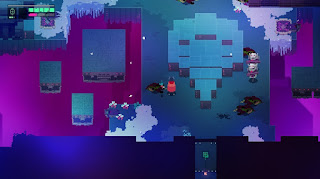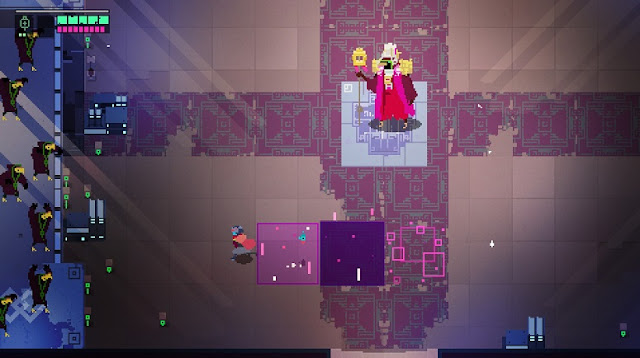Oh look, it's a video game blog. In an age rife with YouTube gamers something like this is almost quaint...
Monday, 4 April 2016
Hyper Light Drifter
Having been watching this game off and on since it was announced, I’ve been curious just how Hyper Light Drifter would finally turn out. It has some very eye catching visuals with very pretty pixel art that really helped the game to get its foot in the door, but it’s followed up with a Zelda-inspired experience filled with opportunities to explore and some reasonably challenging baddies to cross swords with.
There have been no lack of games to come along in recent years to go the pixelated route with obvious nods to games of the past. Some of these have been good, others not so much. HLD is definitely in the first camp. It’s visiting a lot of stuff we’ve seen before like the aforementioned Zelda series, but there’s just so much polish here. Combat is fluid and fast-paced, there’s a heavy emphasis on exploration and non-linearity, environments and characters hint at a massive backstory, and the aesthetic of the game is its own instead of just being another pixel art game that looks like something straight off the NES or SNES. This is the sort of game that serves as an excellent example of something that taps into retro games without feeling derivative; at the same time tapping into a lot of modern sensibilities.
At its heart, the game has a lot in common with old classic Zelda titles with its overhead view, combat style, and so much exploration. In fact, combat feels smoother and faster than anything I’ve ever come across in a Zelda game. Given what HLD throws at players, though, it’s easy to see this being a necessity. It’s definitely a challenging game. That being said, I think most people’s opinion of this will hinge on how much they’ve played old 8 and 16-bit games of this ilk. If you have indeed played a number of those types of games, HLD will seem reasonably manageable, though still fairly challenging, but those who haven’t may run into difficulty.
Enemies all have patterns and tells to their attacks. One needs to simply pay attention for a moment and watch the baddies do their thing while making use of the dodge button so they don’t get hit. It doesn’t take long to figure out what types of attacks enemies do and what sort of animation they perform before unleashing it so that players have the good sense to get out of the way. It only gets really intense when a room locks the player in and a bunch of enemies spawn at once to swarm the hero. In this case, things do get dicey, requiring some fancy footwork to dodge everything enemies throw at the player. Even then, it’s not insurmountable. The game doesn’t just drop players into these situations. It eases them in. Players are slowly introduced to the different enemies, and only after making it a fair way into a given dungeon do they find themselves in such situations.
Bosses too are a matter of learning patterns. If anything, I found these guys easier than some of the swarming incidents. They have very discernible patterns that don’t take long to learn, and it’s simply a matter of execution after in order to take them down. Really, these were the most reminiscent element of 16-bit gaming in HLD for me.
Your character also has a variety of unlockable abilities that can be purchased from trainers in the hub town of the game. While wandering around the countryside, players will gradually gather little yellow tokens and once they have enough they can be exchanged with the trainer for a new skill. These tokens are actually quite rare. They aren’t like coins that can be farmed to one’s heart’s content. They’re hidden in boxes and sometimes drop from enemies, but once they’ve been collected they never respawn. Also, once they’ve been spent there’s no turning back because the game automatically overwrites your last save after purchase, preventing save scumming whereby if players don’t like the ability they can just load up an old save and try something else. That just isn’t allowed here. As such, players need to think long and hard before buying a skill because once they have it that’s it, they’re stuck with it. If they want another they’ll have to head out into the wilderness and figure out where the rest of the hidden tokens are. So, in that regard there are some choices that have consequences in this game.
All the while, there’s quite a bit of exploration to be had. Players start in a hub town situated at the center of the world map with four exits: North, South, East, and West. From there it’s up to the individual to where they want to go. Generally each path leads to some sort of major temple where a boss is waiting to be defeated and some ancient device needs to be activated, but along the way there are no lack of detours to go on. There are a number of smaller power devices and keys that need to be found in order to get to a boss, so players need to wander around and find all of these as well, venturing down different paths. Some of these can be quite hard to find, and actually require you to run your character against the edges of an area. At some point, they may pop into a hidden passage tucked away behind a building or beneath a canopy of trees. They can be tough to see, but once found it’s quite satisfying, especially because they usually lead to useful goodies like more yellow tokens, health packs, or dungeon entrances.
As one wanders this world, it’s hard not to wonder about its past. Just from looking at the surroundings, it’s obvious that players are in some sort of post apocalyptic setting. There are ruined buildings, old broken down robots, and dilapidated cannons everywhere, overgrown with foliage, being clear remnants of a fallen civilization. With all of this, though, we don’t get much explanation of how all this came to pass or why we’re doing what we’re doing in HLD. This is a very intentional approach, as the game has no dialogue in it. Any time the player talks with an NPC, they aren't greeted with a text bubble. Instead, a window opens with a series of still images depicting a short story. It’s enough to get the idea across but leaves a lot open to the imagination. While it does leave the player with some questions, at the same time it helps build a sense of wonder about HLD’s world as one tries to fill in the blanks on their own.
Also building this sense of wonder is the game’s aesthetic, as it has some of the nicest pixel art to come along in the last little while. HLD’s graphics very much have a personality of their own in terms of character and enemy designs, environments, and even the color scheme. As mentioned earlier, far too many pixel art games simply mimic things we’ve seen in 8 and 16-bit consoles, but this one does its own thing, allowing HLD to clearly stand out from other pixelated projects available.
The music also helps to enhance the experience. It has a very analogue synth feel to it reminiscent of Blade Runner. The game has the same composer as Fez, so it’s easy to see the similarities between the two. It works quite well here with the generally mellow, whirring minimalism of the synthesizers building the sense of wonder and loss permeating through HLD’s world.
In the end, Hyper Light Drifter is a game people who like Zelda-esque action adventures should consider spending some time with. There have been plenty of other games to come along and provide similar experiences, but HLD is so much more polished while developing a personality of its own. The game is fairly challenging, but by no means impossible (if anything, I’d say that the Dark Souls series gives me more trouble than this did). With games like Dark Souls III, Quantum Break, and the HTC Vive coming out about now, there’s a chance HLD might fall between the cracks, but it’s a game that really deserves to be played. It just does so many things right, and looks great doing it.
Labels:
game reviews,
Indie,
pc games,
playstation 4,
Retro,
xbox one




